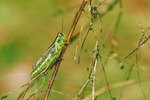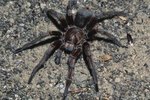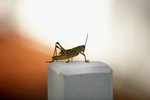
The Mojave Desert encompasses over 50,000 square miles in California, Arizona and Utah. This vast expanse boasts thousands of species of flora and fauna adapted to its harsh conditions. Some of the Mojave's insect species live symbiotically with desert plants. Other types of insects are found only in this desert. It's possible that some Mojave insect species still await discovery. Scientists are still unsure how many species of ants inhabits the region.
Camel Spiders
Also known as wind scorpions and sun scorpions, camel spiders consume a lot of other Mojave Desert insects. Two inches long at maturity, these eight-legged creatures move very quickly. Full-grown camel spiders are capable of devouring small lizards, in addition to favorite fare, such as actual scorpions and black widow spiders. The camel spider's two front legs also work as feelers, which hold the prey while the spider's jaws tear it apart. The camel spider eats all of its kill, leaving no trace of the victim.
Pronuba Moth
The pronuba moth and the yucca depend on each other for survival in the Mojave. The female moth lays eggs in the yucca flower, which she also pollinates. After hatching, moth larvae eat many of the yucca seeds, but there are still sufficient numbers of seeds to mature and continue the next generation. In the Mojave, only the pronuba moth pollinates the yucca. For obvious reasons, the pronuba moth is often referred to as the yucca moth. This small, silvery-white moth spends most of its life on the yucca plant, flying from one to another.
Kelso Dunes Insects
Ammopelmatus kelsoensis, the Kelso Dunes Jerusalem cricket, is found only in the Mojave Desert. This rare, large nocturnal species inhabits the interior of sand dunes. The equally rare Eremopedes kelsoensis, the Kelso Dunes shieldback katydid, was discovered by scientists in 1972. This gray or green insect has a white stripe running along the length of the abdomen.
Tarantula Hawk
Tarantulas call the Mojave home, and so does the tarantula hawk (Pepsis sp.). These wasps, maturing at 2 inches in length, sport dark bodies and orange or black wings. The female wasp finds a tarantula via smell, then paralyzes it with her sting. She then lays an egg on its body and drags it back to her burrow. The hatched larva eats the tarantula, which might not be dead before being devoured through several larval molts.
References
- National Park Service: Ant Fauna of the Mojave National Preserve
- Mojave Desert Land Trust: Camel Spiders
- National Park Service: Insects, Spiders, Centipedes, Millipedes
- World Wildlife Organization: Mojave Desert
- Desert USA: Yucca Moth
- California Department of Fish and Game: Ammopelmatus Kelsoensis
- University of Florida: Neartic Desert Sand Dune Orthoptera Part XIV A New Eremopedes (Decticidae)
- Desert USA: Tarantula Hawk
Photo Credits
-
Hemera Technologies/AbleStock.com/Getty Images
Writer Bio
Jane Meggitt has been a writer for more than 20 years. In addition to reporting for a major newspaper chain, she has been published in "Horse News," "Suburban Classic," "Hoof Beats," "Equine Journal" and other publications. She has a Bachelor of Arts in English from New York University and an Associate of Arts from the American Academy of Dramatics Arts, New York City.




